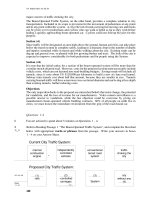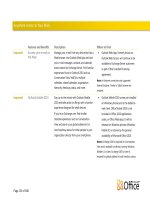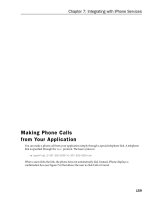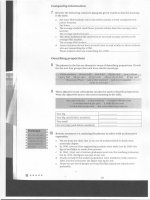Tài liệu Opportunities in technical writing careers part 14 pptx
Bạn đang xem bản rút gọn của tài liệu. Xem và tải ngay bản đầy đủ của tài liệu tại đây (92.74 KB, 10 trang )
an associate editor of a journal of sports medicine and an editorial
consultant to the Eisenhower Medical Center.
Another writer who has a B.A. in journalism worked briefly as
editor of a trade publication and later became an editor for a pub-
lishing firm that produces technical books and pamphlets. He then
joined a state health department as an editor of its monthly maga-
zine. His current duties include writing and editing pamphlets,
booklets, and brochures for all units within the department; prepar-
ing the annual report; and preparing news releases concerning
department activities and providing information for the press.
When asked to classify his position, he describes himself as a pub-
lic health writer.
Many physicians have become medical writers, just as many engi-
neers have become technical writers. For example, one writer
received a degree in pharmacology from one college, a B.S. degree
from another, and a medical degree from a third. He has been both
a practicing pharmacist and a physician and has also served as med-
ical director and director of research for a large chemical manu-
facturing company. He is now employed by a New York advertising
firm as medical director in charge of clinical research. It is the job
of his department to delve into the research and manufacture of
the drugs and chemicals of his client firms so that they may be
advertised intelligently and accurately in the medical journals.
American Medical Writers Association
The aim of the American Medical Writers Association is to bring
together all North Americans who are employed in the communi-
cation of medicine and allied sciences in order to maintain and
advance high professional standards. Its purpose is educational, sci-
Related Fields and Growing Trends 121
entific, and literary. At an annual meeting addressed by distin-
guished authors, editors, and teachers, members have the opportu-
nity to keep informed on the progress being made to maintain and
advance high professional standards and thus to aid in general med-
ical advancement.
The association publishes the AMWA Journal, which is delivered
quarterly to members and subscribers. It is an authoritative, com-
prehensive source of information about the knowledge, skills, and
opportunities in the field of medical communication worldwide.
AMWA offers an extensive continuing education program that
allows professionals in the medical and allied scientific communi-
cation fields to explore new areas of expertise in order to enhance
their skills. More than one hundred educational sessions are offered
during a three-day annual conference, including curriculum work-
shops that can also be applied toward AMWA’s certificate pro-
grams. Earning an AMWA certificate is considered part of a career
path in the field and is required by some employers.
Workshops are also offered at AMWA chapter-sponsored con-
ferences presented at various times during the year, and approxi-
mately twenty workshops are available for on-site presentation at
companies’ facilities. There are also a number of self-study work-
shops available that include a combination of a workbook and
CD-ROM. Two examples are Basic Grammar and Usage and Punc-
tuation for Clarity and Style, which can be ordered through the
AMWA website.
AMWA Certificate Programs
AMWA offers three certificate programs: core, advanced, and sci-
ence fundamentals. Participants in core workshops can learn how
to improve editing, writing, communication, and bibliographic
122 Opportunities in Technical Writing Careers
skills; how to develop and manage a freelance business; learn the
skills necessary for writing for the pharmaceutical industry, public
relations/advertising/marketing, or Web/multimedia; discover the
latest methods for educating writers and editors; and brush up on
statistics. Advanced workshops provide experienced medical com-
municators with in-depth consideration of issues in writing, edit-
ing, management, bibliographic research, education, and other
topics of interest. Workshops in science fundamentals offer partic-
ipants an opportunity to deepen their understanding of basic con-
cepts in science and medicine. This curriculum is designed for
medical communicators who do not have a university background
in science and for those educated in science who wish to learn more
about areas outside their specialties.
Core Certificate
Participants can earn a core certificate in one or more of five spe-
cialty areas: editing/writing, educators, freelance, pharmaceutical,
and public relations/advertising/marketing. To receive a certificate,
participants must successfully complete four general workshops and
four additional workshops from the specialty area of their choice.
Participants may also earn a multidisciplinary core certificate by
successfully completing four general workshops and six specialty
workshops chosen from three or more of the specialty areas.
Multiple Certificates
After earning their first core certificate, participants can earn addi-
tional certificates in different specialty areas. For each new certifi-
cate, participants must pay an additional enrollment fee and then
complete four more workshops from the new specialty area. The
work for each new certificate must be completed within four years.
Related Fields and Growing Trends 123
Science Fundamentals Certificate
Participants must successfully complete four general science work-
shops and four additional workshops from specialty areas such as
body systems, diseases, or diagnostics and therapeutics.
AMWA Advanced Certificate
The advanced workshops are designed for those who have earned
AMWA core certificates or have a minimum of five years of expe-
rience in the topic covered by the specific workshop. Earning an
advanced certificate requires the completion of eight advanced
workshops. Some advanced workshops require core workshop pre-
requisites that cannot be waived. Therefore, in choosing core work-
shops, participants should consider which advanced workshops they
may eventually want to take.
Business Writing
If you choose a career in business writing, you may be dealing with
readers ranging from business managers to the general public and
with such topics as human resources to consumer relations.
In planning a career in business writing, you should study busi-
ness and the communication of business. Since business writing is
highly specialized, it is important to carefully select the kind of
writing or editing you will train for. It’s one thing to write repair
manuals, but something else altogether to write training materials
for the sales personnel. You should assemble a portfolio of samples
of your work, and you should learn to write good letters of appli-
cation to accompany your professional portfolio.
124 Opportunities in Technical Writing Careers
Types of Business Writers
Business writers fall into a number of classifications, including the
following, which are adapted from the IABC.
• Informal auditor. Performs operational reviews and reports
on recommendations for management
• Financial analyst. Does analytical reporting
• Accountant. Writes company policies and procedures
• Researcher (advertising). Gathers, organizes, and writes
final reports; makes formal presentations of findings to
clients
• Product advertiser. Plans and coordinates product
development; composes literature and sales aids
• Community planning specialist. Writes, edits, and reports
on community concerns
• Planning director. Oversees and prepares copy for
promotional literature
• Publications specialist. Prepares original copy, graphic arts,
and layouts
• Corporate relations officer. Writes news releases and edits
materials
• Proposal specialist. Plans, writes, and produces contract
proposals
This is only a partial list of the possibilities for business writers.
In all the descriptions, you will find that, once again, there is an
overlapping of job duties among business, medical, and technical
communicators.
Related Fields and Growing Trends 125
International Association of
Business Communicators
IABC is the professional organization for business writers. Its more
than fourteen thousand members are from seventy countries, and
they work in every aspect of business communication.
The aims of IABC are similar to those expressed by STC and
AMWA: to promote professional standards and provide a forum for
its members. IABC carries out its purpose through an annual
national convention and regional meetings and seminars offered
throughout the year by individual chapters.
IABC publishes Communication World, its magazine for mem-
bers that offers articles written by leaders in the field of business
communication. CW Bulletin is an e-newsletter supplement to the
journal that is sent to all members every month.
The association also sponsors Student Connection, a variety of
resources and opportunities for students who plan to enter the com-
munication profession. It allows students to gain insights from lead-
ers in the profession, make valuable contacts, and supplement their
academic education with practical training.
IABC Training
The IABC offers training opportunities ranging from in-depth con-
ferences and seminars to convenient distance-learning sessions
delivered directly to your office. The options in distance learning
include teleseminars, Web seminars, and online seminars. Tele-
seminars are sixty-minute telephone sessions led by IABC confer-
ence speakers and include downloadable handouts. Web seminars
are ninety-minute telephone sessions with visuals presented on the
Web. Online seminars consist of ten hours of training taken dur-
126 Opportunities in Technical Writing Careers
ing a two-week period. Members who complete four seminars earn
a professional certificate in strategic communication management.
Accreditation
Accreditation is an IABC professional development program that
allows communicators to demonstrate their ability to think and
plan strategically and to successfully manage the skills essential to
effective organizational communication, which could include inter-
nal communications, media relations, crisis communications, and
external relations.
To earn the designation of accredited business communicator
(ABC), you must be a professional communicator with a minimum
of five years of experience in business communication (organiza-
tional communication, public relations, or communications man-
agement) and a bachelor’s degree or a total of nine years of
combined postsecondary education and/or experience.
There are three steps to the accreditation process, each of which
must be successfully completed before proceeding to the next. The
steps are an application, qualification (the portfolio), and written
and oral examinations. Each portion of the process contributes to
your score—the portfolio grade counts for 25 percent of the total,
the written exam counts for 58 percent of the total, and the oral
exam counts for 17 percent of the total.
• Application. Your application should be a comprehensive sum-
mary of your professional experience and qualifications; it will be
used to determine your eligibility to proceed with the accreditation
process. Several IABC chapters offer accreditation workshops and
local mentoring programs to help candidates present the most com-
pelling applications.
Related Fields and Growing Trends 127
• Qualification: The portfolio. Your portfolio must include
two work samples, with work plans to demonstrate the range of
communication projects or programs you’ve been responsible for
and your ability to plan and work strategically. Candidates must
receive a passing score of 4.0 or better (using a 0–7 scale) on the
portfolio to qualify to take the examination.
• Examination. The examination tests your knowledge of com-
munication and management skills. The exam is four and a half
hours long and includes a written and oral test.
Visit www.iabc.com for complete information about the accred-
itation process and the dates and locations of upcoming exams.
Trends in Professional Education
More and more colleges, universities, and technical schools are
offering courses and programs in technical communication, mak-
ing it easier than ever for you to find the curriculum you want in a
school near you.
Another trend in professional education is employers’ increasing
interest in graduates with master’s degrees. An advanced program
of this sort will give you the time to acquire more skills and is fre-
quently a step toward a supervisory or management job. Human
resources interviewers are always looking to the future—do the
candidates for a job have the characteristics and skills that will favor
promotion into managerial positions?
Global Information
Companies also are looking for applicants who can handle world-
wide documentation systems. Technical writing students must be
128 Opportunities in Technical Writing Careers
trained in the operation of these communication systems and on
procedures in sorting out data and dealing with foreign countries
that need the data.
If you examine the course listings of most colleges, you will find
classes that address the subject of global information. Communi-
cation systems are now standard in many colleges, and courses in
technical German, French, and other foreign languages are avail-
able, too.
Machine Translation
If you have knowledge of one or more foreign languages and are
skilled in technical writing, you should be well equipped to work
with translating equipment to convert foreign languages into
English and vice versa.
Machine translation (MT) is a subfield of computational lin-
guistics that investigates the use of computer software to translate
text or speech from one natural language to another. At the most
basic level, MT performs simple substitution of words in one lan-
guage for words in another. Using advanced techniques, more com-
plex translations may be attempted, allowing for better handling of
differences in phrase recognition and translation of idioms.
Current machine translation software often allows for cus-
tomization by domain or subject area, which improves output by
limiting the scope of allowable substitutions. This technique is most
effective in domains where formal or formulaic language is used.
For example, machine translation of government and legal docu-
ments more readily produces usable output than conversation or
less standardized text.
To give you some idea of how translators and technical writers
may work in machine translation, we contacted William L. Ben-
Related Fields and Growing Trends 129
zon, a renowned expert in technical communication. Dr. Benzon
is associate director of the World Development Endowment Foun-
dation and a former assistant professor of communication at Rens-
selaer Polytechnic Institute. He said:
As high technology spreads across the globe, the need for rapid,
reliable, and relatively cheap translation of technical documenta-
tion grows proportionately. Translation, however, is slow, boring,
but highly skilled work, which adds up to its being very expensive
work as well. On the other hand, computers are fast and they don’t
get bored. If they can be programmed with skills sufficient to the
task, then fast and cheap translation may be possible.
Whether translation can be done by machines depends on the
fact that most of the decisions to be made in translation are, in prin-
ciple, as routine as the multiplication tables. Those decisions can be
made quickly and accurately by a computer with the requisite soft-
ware. However, many of those decisions depend on prior decisions
of a different class, decisions that cannot be specified by some rou-
tine procedure. These decisions concern the meaning of the text
and seem to require encyclopedic knowledge of the text’s content.
Current software provides literal, not idiomatic (everyday) language
translations, so its use is restricted. Translated text must be con-
verted into good idiomatic language, and there is an ongoing effort
to solve this problem.
To illustrate the difficulty of idiomatic versus literal translation,
consider the phrase, “the coast is clear.” In Spanish, the equivalent
phrase is no haber ningunos moros en la costa, whose literal transla-
tion is “there are no Moors on the shore!”
At present there are more practical machine aids to human trans-
lators, called MAT (machine-aided translation). Several MAT sys-
tems are in use by government agencies and private corporations,
130 Opportunities in Technical Writing Careers









